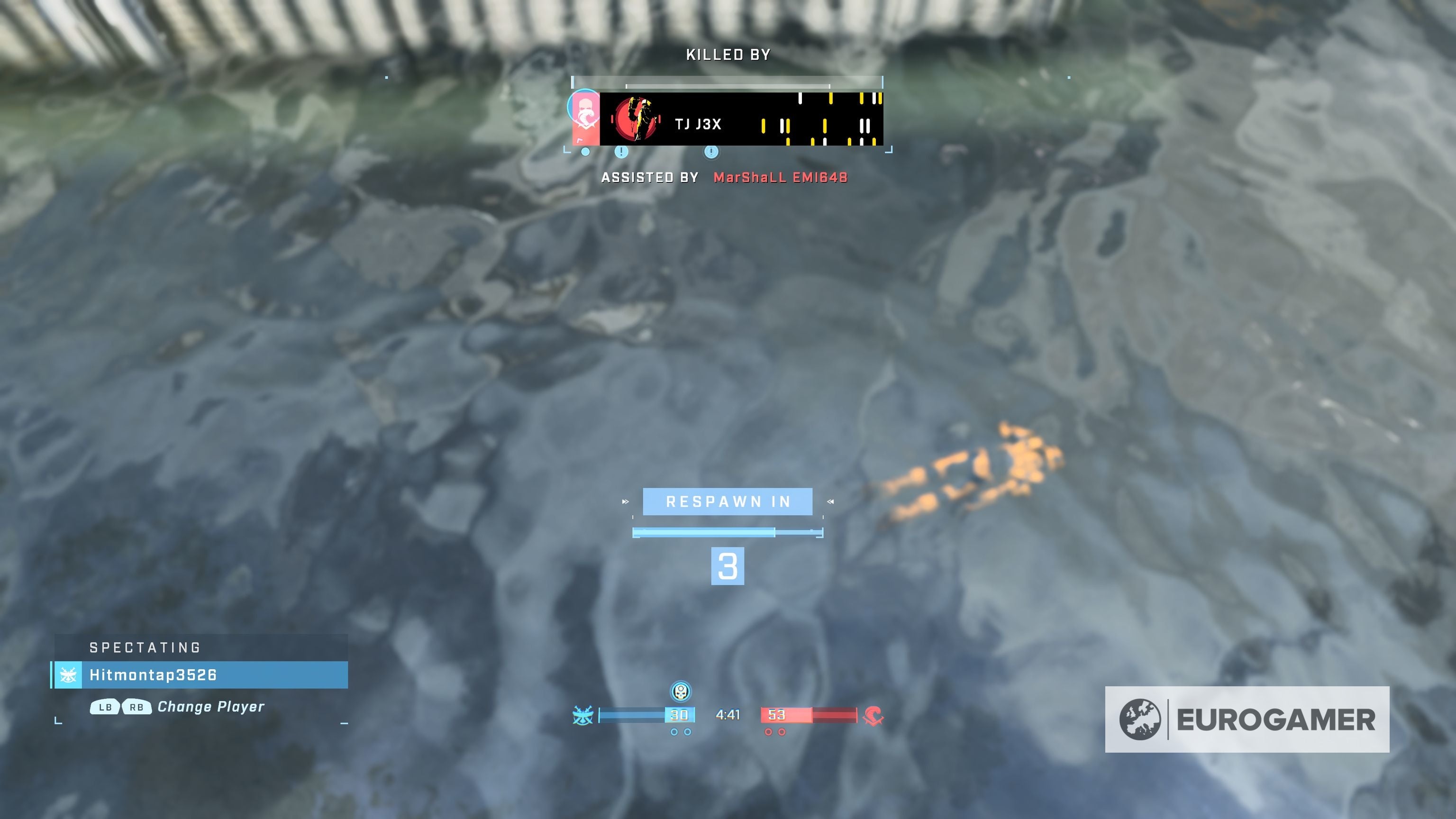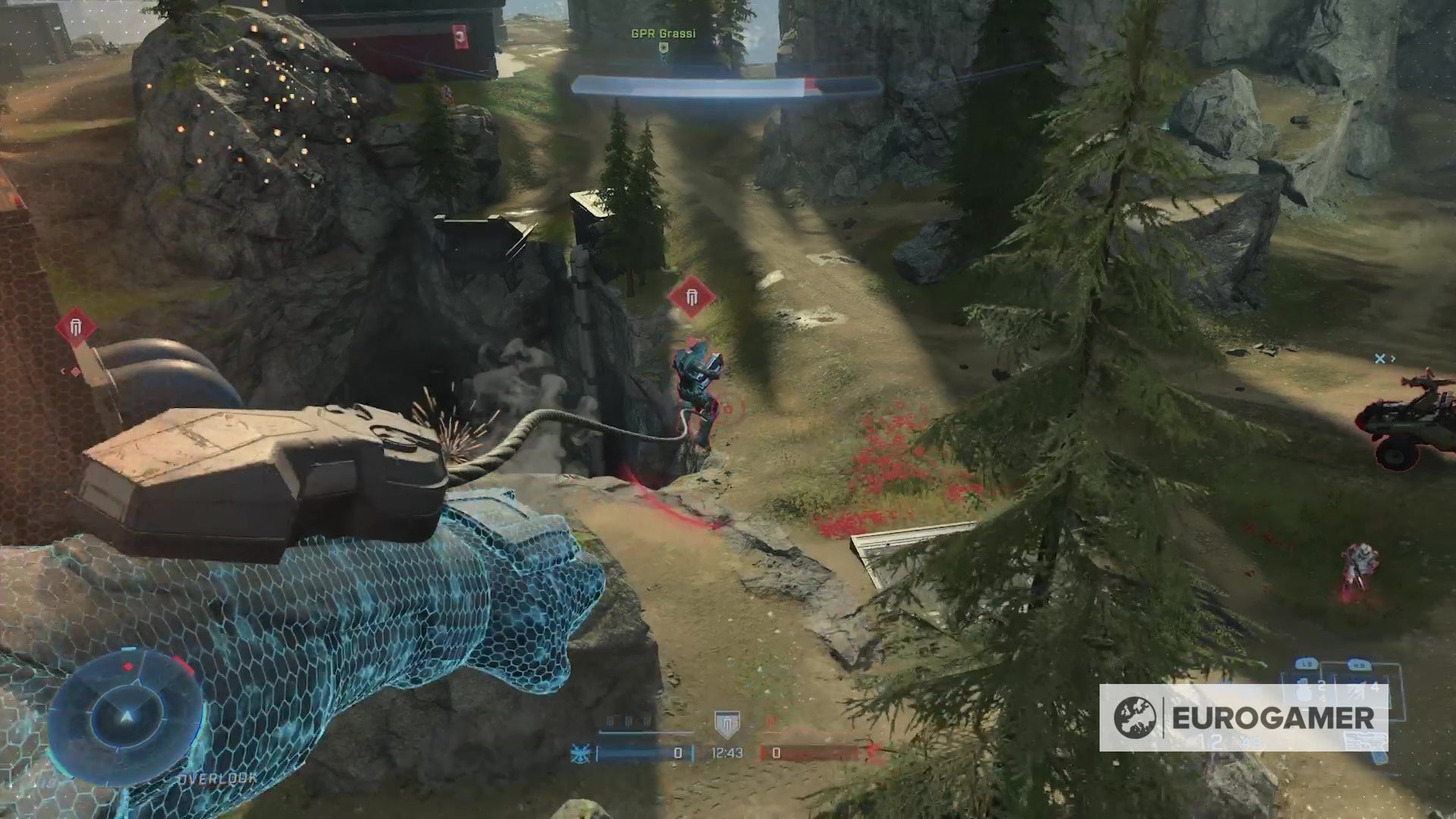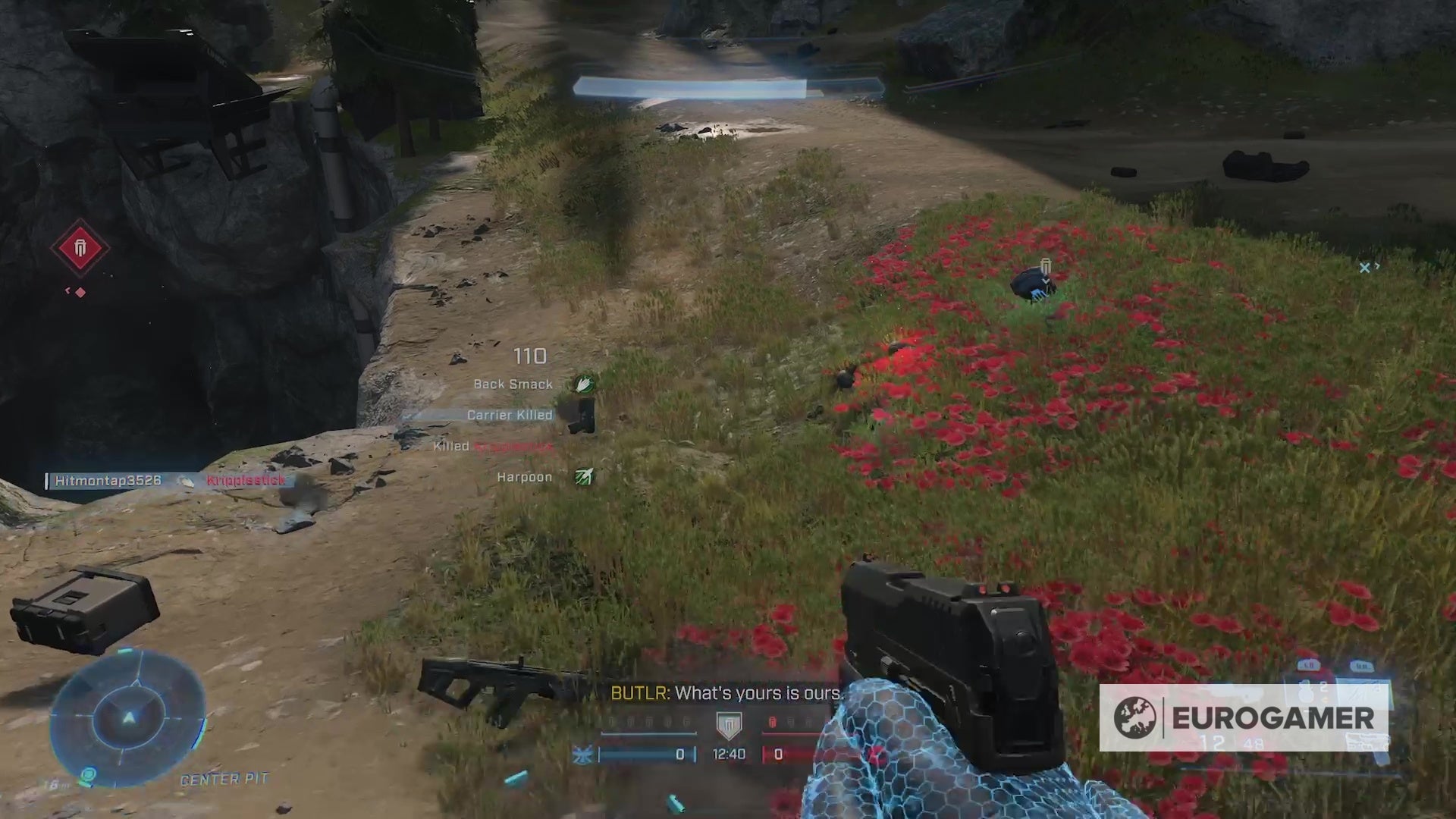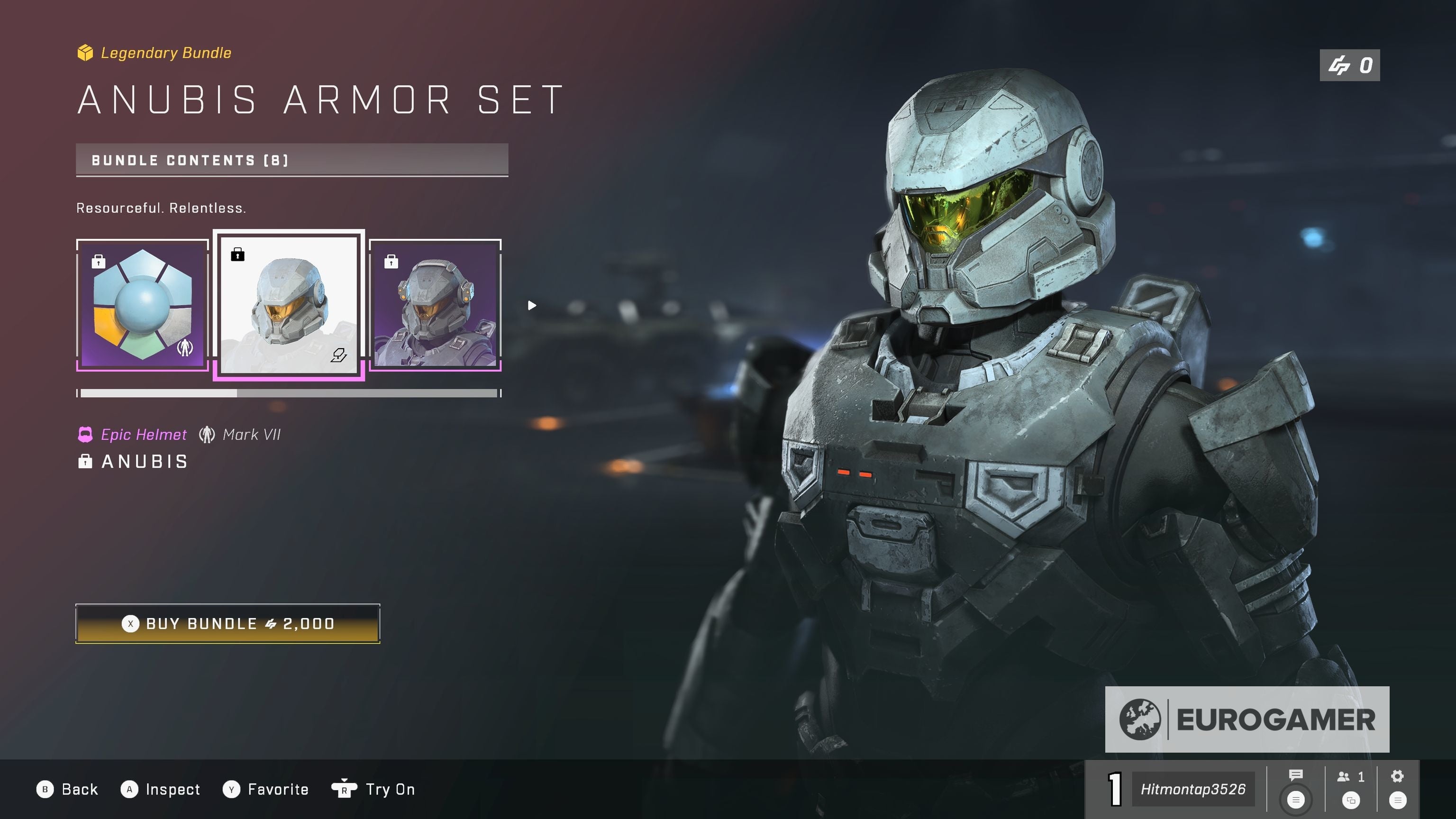No. Not in terms of gunplay, at least - of gunfeel, of the constant cycling between empowerment and disempowerment and the much-harder-than-it-looks balance that so many shooters yearn for, between that immediate, crunchy, punch-feedback satisfaction and Halo’s famously slower, big-brain strategy. No there is not. I’ve spent weeks picking at this game, prodding it and poking it and peeling away at the edges to try and uncover some kind of flaw, and I can’t. As far as the moment-to-moment of multiplayer shooters goes, it’s immaculate. This, genuinely, is as good as it gets. The only problem is the front end - the meta-game or the UX or whatever that kind of menu-based wrapping of a game is called these days. There are some quirks there, some weird choices that threaten to muddy the otherwise pure waters of Halo Infinite’s “golden triangle”. But thankfully in most cases you can - and probably should - ignore them. If you’re unfamiliar, Halo Infinite’s multiplayer and its campaign are effectively separate games. The Halo Infinite campaign, which Eurogamer’s Wesley Yin-Poole mostly loved, is a paid-for thing that stands on its own (although there are a few collectibles that unlock cosmetics in the multiplayer, presumably to help encourage players to try both). The multiplayer is free and separate. By modern standards, a year and a half after Call of Duty Warzone split off from the annual CoD and several after Fortnite transcended Fortnite, that’s nothing new. But it’s a fairly radical first for Halo, a series that has for much of its later life been defined by its conservatism. It’s a theme that runs through Halo Infinite: a cascade of little-firsts, mini-revolutions, tiny, barely perceptible tweaks and changes. The thing they all share is their un-Haloness, the fact that five, ten years ago the Chief wouldn’t be seen dead with any one of them, but that now feel like they’ve been there all along. Maybe the best example is the Assault Rifle, Master Chief’s trusty default weapon that once seemed to barely tickle enemies with its rounds of fluttering eyelashes, but now positively bellows down at them, each bullet a hammer blow from the gods. Evolving sound design is one thing - an area that’s been reliably improving with each 343 Industries Halo but reaches a thunderous, superlative pitch here in Infinite - but the effect, intentional or not, is an acute sense of viability. For so long the AR has been the designated swap-out fodder in Halo, whichever part of the game you’re playing, but the sense of crunching feedback in Infinite makes me oddly reluctant. The actual damage, as far as I know - the meat and bones of how many bullets it fires, how fast they fire and how hard they hit - is more or less the same as ever, but combined with a new, tasty little red cross to confirm the kill, a new, CoD-like ft-ft-ft when you’re landing a hit, and the left-trigger “smart scope” controversially added in Halo 5, and you get a kind of magic placebo buff. Suddenly I’m good - weirdly good - at using a weapon that I don’t think has changed. It’s a good example of what Halo Infinite really is, too, because it’s so obviously the original Call of Duty: Modern Warfare that inspired these tweaks - or at least kicked off the decade-plus of shooter trends that since inspired them in Halo Infinite - and it was that Modern Warfare, releasing about 40 days after the series-peak Halo 3, that threatened to undermine everything Halo was. Halo’s allergy to change felt like a direct, if involuntary response, a stubborn digging-in and doubling-down on what “real Halo” ought to be that 343 has clearly struggled under since taking over from Bungie (and you can’t blame the team for that catch-22: stick with old Halo and get left behind, or change too much and be accused of not getting it?). Where Halo was wincing at the thought of a continuous sprint button, Titanfall was double-jumping off walls. By the time Halo got that ADS-that-still-isn’t-actually-ADS off the clickable Right Stick and onto LT, PlayerUnknown’s Battlegrounds was rattling the cages of every shooter with a hundred-player battle royale. Now, a poetic justice: Halo’s stubbornness sank it, but that time out of the limelight, out of the common mind and frankly out of the entire conversation on what first-person shooters are has allowed it to perform a kind of dramatic re-emergence, Infinite stepping out onto the scene like some third act rom-com glow up. 343 has been stuck in what looked like a doomed existential crisis, every new game stirring us all up into a debate about Halo’s “essence” and “purpose” and what makes Halo Halo - what we even liked about in the first place and whether it can even work now. Suddenly the series was this playable Ship of Theseus; how many old weapons can you swap out for new ones before you’ve built a whole new series? With Infinite, that stubbornness seems to have finally come around to work in Halo’s favour, because now those little changes feel so big, so new, and the many big things that don’t change from the formula suddenly feel like bold affirmations, instead of fearful resistance. Halo is not a hip-fire game because it’s scared to compromise, or worried that it might be seen as “copying” the dominant Call of Duty, seen as being forced to change by another game’s success, or its new studio seen as too duty-bound to the Bungie formula. Halo is a hip-fire game because hip-fire is awesome, because it makes you feel a kind of mythic power in your nonchalance, because timidly bringing your rifle up to look down the sights is the feeble little Jackal’s method, and you are a Spartan. Halo is finally able to stand up and make that affirmation because it’s realised, as a series, that it can do whatever the hell it wants. After that, the rest of Halo Infinite feels like a celebration - this is a game that’s discovered its purpose anew, and its purpose, apparently, is to simply make everything feel absolutely incredible. In every interaction it’s like the fog has been cleared, the line between brain and game has been shortened. In many ways Halo Infinite is the perfect Halo remaster: this is not actually what classic Halo felt like, but it’s what you think it felt like, 15 years on. Ghosts, for instance, feel a little faster, more agile, less drifty and more prone to flipping onto their domed, crabby little backs if you get a corner wrong. Highlights - actual highlights I’ve become addicted to clipping, to share with anyone who’ll watch - seem to happen once a minute. Toys are everywhere, the spread of power weapons extra generous along with the added boon of those lovely glowing blue containers that just beg to be hoiked at a cluster of enemies, ideally while you waft above them, catapulted off a launch pad. Everything is so physical, so kinetic. Everything connects. Drive this off there then grapple hook that. Jump here, throw this, skewer that enemy and wallop the other when you land. Half the fun of finally nabbing a flying vehicle is to stop yourself and just watch, for a second, while the uniquely scientific chaos unfolds below, rockets and Mongeese and cadavers whirling about some objective like the planets of an orrery. The other half is joining in. It really is magic - the magic of playing physics in motion - and so it’s a crying shame when the small annoyances of that overlayer creep in. The glaring one, that is actually capable of affecting the playing of the game, is the lack of Slayer playlist. Right now you can only choose between small-sided 4v4 matches or Big Team Battle (or ranked), but within those two playlists it’s just a random chance that dictates what mode you get. The result is some players, clearly and actually quite understandably, playing to rack up kills in modes that require proper cohesive work towards an objective, along with lots of matching, “go play Slayer” remarks dropped in the in-game chat. It’s just one split that it really needs, between objective and non-objective playlists, and while Halo Infinite will have likely had a good few technical hiccups spurring that year-long delay there must surely be a simple, workable solution here - not least because it’s a front-end choice that impacts the playing experience, and one the series has had for so long before now. There’s also a bit of a thinness to it, generally. There are just a handful of maps at launch - they are brilliant, at least - and again a bit of a paucity of modes within the two playlists. I miss the weird stuff, the 4am rounds of Grifball, shotty snipers, and the oddly spooky Infection. Others will surely miss the PvE Firefight. I miss the Forge World maps, something I never thought I’d say, just because of the variety their eerie vibe peppered into the game. I definitely miss SWAT. Some of these are coming, in some form, some time after launch, but according to one 343 developer’s tweet that won’t be before the end of the year. That’s a theme that lingers with Halo Infinite, across the campaign as well as the single-player, and it’s a shame after such a hefty delay to still feel a yearning for the things that are still to come. The choice to play an objective mode or not should unequivocally be there at launch. Finally, there is a battle pass. This is how Halo Infinite is paid for - it is completely free to play itself, and nothing in the pass impacts the way the game plays - and so it’s a necessary evil. There are issues with progression; it is slow and boring, even after tweaks during the beta, but the problem with battle passes isn’t the rate at which you can get through them so much as the fact they create a compulsion to get through them at all. Engagement bait is a grim practice and one that’s everywhere, Halo Infinite far from an exception and far from the worst example - but it’s still grim. Creating a compulsion to play more through added objectives treats gameplay as a means to an end, forging a kind of quasi-addiction and shifting the value and the sense of reward away from the act of gameplay itself. It sucks. At the same time, you can just ignore it. This is what I’ve done and what I expect I’ll always do, because playing this game feels incredible (and because I just want to paint my Spartan a kind of burnt orange, which is already possible without the pass). This is the newly rediscovered goal of Halo, and this again is the point with Halo Infinite. You are free to simply not care about external influences, to not care about the impression of “giving in” that might have once come when Halo adds a sprint, when gameplay feels faster (regardless of whether it demonstrably is), when there’s newly heightened urge to pelt back into the action after death, and when vehicles and power weapons drop from the sky like the killstreaks of CoD or loot crates of a battle royale. What matters is you can choose to care about what you value. What Halo Infinite chooses to value is a heavenly satisfaction that makes this series’ old, arcadey soul feel new. What I choose to value is… also that.








